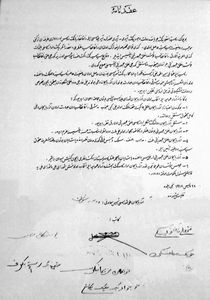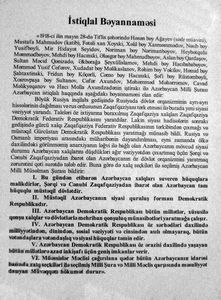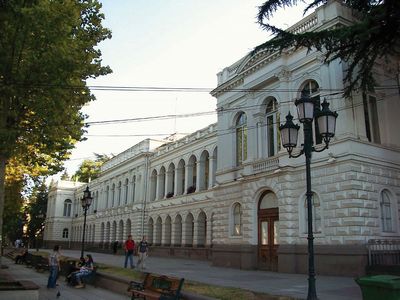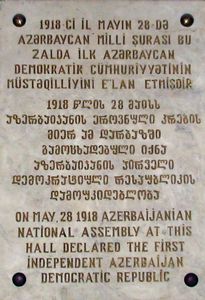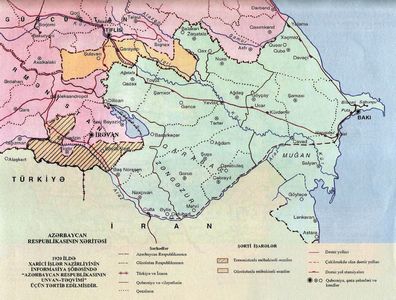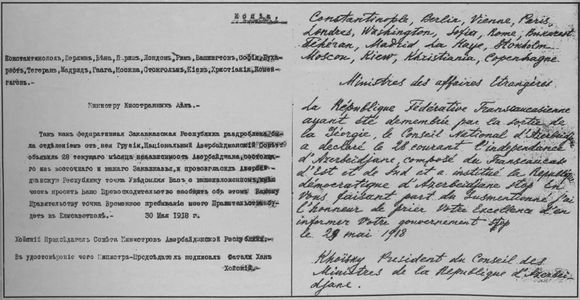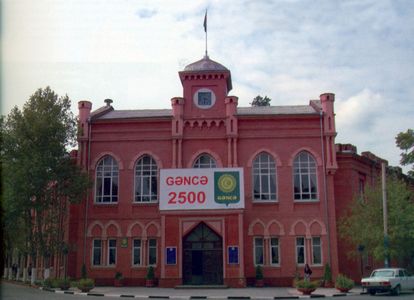Establishment of Azerbaijan Republic
Complex social and political processes which began in XIX century resulted in fundamental changes in Azerbaijan society, meanwhile outstanding public and political figures of the new faction could adequately cope with the most serious challenges of the epoch it is facing. But particularly, the existence of favorable terms and circumstances led to establishment of independent state.
On 27 May, 1918 the Muslim Faction of the Trans-Caucasus Seim held a separate meeting and adopted a decision to declare independence of Azerbaijan.In that regard, the faction declared itself the National Council of Azerbaijan. Mammed Emin Rasulzadeh was elected a chairman of the National Council.
On 28 May, 1918 was held a historical meeting of the National Council and adopted the Declaration of Independence of Azerbaijan that declared on establishment of the state “Azerbaijan Republic”. The Azerbaijan Democratic Republic was the first parliamentary republic in the Muslim East and became an example of a democratic, law-based and secular state both in the Turkic and Islamic World. The Declaration proclaimed worldwide of the underlying principles of internal and foreign policy of the Azerbaijan: ensures all citizens living within its borders full civil and political rights, regardless of ethnic origin, freely and independently to decide their own fate and determine their form of government, to establish kind friendly relations with all the nations, in particular, with the neighboring nations and states and respect sovereignty and territorial integrity. On 30 May, information, radio telegram was sent to a number of countries throughout the world about the establishment of the Azerbaijan Republic.
The Azerbaijan Republic was established in difficult internal situation as well as in complex foreign-policy circumstances. The power in Baku seized the Bolshevik-Dashnak forces under the leadership of S. Shaumian and committed genocide against Azerbaijanis. Competitive clash of interests caused by outer forces which aimed to take control over Baku oil significantly made the situation more complicated. Ottoman state was the first country that recognized the independence of Azerbaijan: On 4 June, 1918 between Ottoman state and Azerbaijan Republic was signed the Treaty on peace and friendship.
Baku was proclaimed the capital of the state; nevertheless Baku was in the hands of Bolshevik and Dashnak forces.
M.E. Rasulzadeh in his appeal showed that government of Azerbaijan was firmly resolved to win the city back: “The people of Azerbaijan, who never stood back and drop the idea of the achievement of independence of the state, and will never renounce an idea to return Baku as well. Today, it is not only territorial issue for Azerbaijan but the question of life and death of the whole nation”.
I Cabinet of Government of Azerbaijan Republic
May 28- June 17, 1918
Chairman of the Council of Ministers and Minister of Internal Affairs– Fatali Khan Khoyski
Minister of Defense – Khosrof Pasha Bey Sultanov
Minister of Foreign Affairs – Mammadhasan Hajinski
Minister of Finance and Public Education – Nasib Bey Yusifbeyli
Minister of Justice – Khalil Bey Khasmammadov
Minister of Trade and Industry – Mammadyusif Jafarov
Minister of Agriculture and Labour – Akpar Agha Sheykhulislamov
Minister of Transportation, Postal Service and Telegraph – Khudadat Bey Malikaslanov
Minister of State Control – Jamo Bey Hajinski
“Ganja period” of Azerbaijan Democratic Republic
16 June-17 September, 1918
On 16 June, 1918, Azerbaijani National Council and Government moved from Tbilisi to Ganja. More than 130 decisions were made during “Ganja period” of the ADR.
On 17 June, the National Council adopted a resolution on giving the whole legislative and executive power to the Azerbaijani government.
The military situation was proclaimed on 19 June. Voluntary groups all over Azerbaijan thronged Ganja. Here they participated in the military trainings and were divided into military units under the leadership of Azerbaijani officers of former Russian army including Ottoman officers arrived in Azerbaijan.
On 24 June, the first flag of the Azerbaijan Republic was adopted. The flag with the description of a white crescent and an eight-pointed star on the red fabric was declared a temporary symbol of the Republic.
“Azerbaijani Special Corps” was formed on 26 June. General Aliagha Shikhlinski was appointed commander of the corps. Ganja Military School began functioning. Regulating relations with the Islamic Army of the Caucasus, Ismayil Khan Ziyadkhanov was assigned chief commissioner on military affairs.
On 27 June, the Azerbaijani language was declared the state language.
Fatali Khan Koyski, the chairman of the Council of Ministers of the Republic, gave an order on establishing the first police department in the country on 2 July.
On 15 July, Emergency Investigation Commission was founded to investigate the crimes on the genocide against Azerbaijanis.
Ganja city, which was named Elisabethpol in the Russian Empire period, officially regained its historical name on 30 July.
On 28 August, a decision was made on conducting lessons in the educational institutions in the native language.
The representative delegation of the Azerbaijan Democratic Republic had a meeting in Istanbul with the government of the Ottoman Empire on 6 September. The delegation led by M.E. Rasulzadeh, the chairman of the National Council, was received by Ottoman sultan Mehmed VI Vahideddin. This was the first overseas visit of the official delegation of the Republic. The issues on rendering military assistance to the Republic and the liberation of Baku were the main discussion topic in the meeting which Ottoman military leader Enver Pasha participated in, too. Following this meeting, launching a decisive attack to Baku was decided.
On 15 September, the units of the Islamic Army of the Caucasus liberated Baku from the occupation of the Bolshevik, Armenian and British military forces and on 17 September, Azerbaijani government moved to Baku.
Second cabinet of Azerbaijan Democratic Republic
17 June-26 December, 1918
Chairman of National Council and Minister of Justice- Fatali Khan Khoyski
Minister of Foreign Affairs (and temporarily, Minister of State Control)- Mammadhasan Hajinski
Minister of Education and Religious Affairs- Nasib Bey Yusifbeyli
Minister of Internal Affairs- Behbud Khan Javanshir
Minister of Agriculture- Khosrov Pasha Bey Sultanov
Minister of Healthcare and Social Security- Khudadat Bey Rafibeyli
Minister of Roads (and temporarily, Minister of Post and Telegraph)- Khudadat Bey Malik-Aslanov
Minister of Trade and Industry- Agha Ashurov
Minister of Finance- Abdulali Bey Amirjanov
Minister without portfolio- Alimardan Bey Topchubashov
Minister without portfolio- Musa Bey Rafiyev
Minister without portfolio- Khalil Bey Khasmammadov
